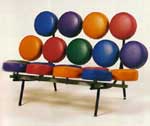Pop Art
 |
|
Marshmallow, George Nelson, American, Designed 1956
Production: 1956 - c. 1965
Size: 77 cm x 131.5 x 80; seat height 42 cm
Material: varnished steel tubing, aluminum, vinyl cusions
Marshmallow transforms a traditional sofa into a three-dimensional structure made of soft, colored cushioning and must be considered one of the earliest Pop Art furniture designs. The seat and back are supported by a steel construction and the unit has the shape of an axially symmetrical folded-out waffle. Unlike traditional upholstered sofas, it was possible to make it available in numerous colors and sizes thanks to what was at the time a completely novel, additive constructive system. However, production required costly labor inputs; additionally, the unorthodox sofa hardly seemed to fit in contemporary interiors. Production at Herman Miller was therefore discontinued around 1965. From 1988 to 1994, Vitra produced the Marshmallow sofa again.
Design Story
Designers George Nelson and Irving Harper designed this furniture icon in 1956. As the 1956 Herman Miller furniture catalog put it, "Despite its astonishing appearance, this piece is very comfortable."
Comfort comes from 18 cushions, upholstered in fabrics or leathers that float on a brushed tubular steel frame with satin black legs. Knowing that the sofa would invite use, Harper and Nelson designed its cushions so that that can be detached for easy cleaning or, as the catalog says, "interchanged to equalize wear."
Nelson once wrote that Herman Miller "is not playing follow-the-leader." That's one reason why George Nelson & Associates worked with Herman Miller for over 25 years as they shepherded design into the modern era.
During this same period, George Nelson & Associates also created many landmark designs of products, showrooms, and exhibitions for a variety of companies and organizations.
Nelson said that for a designer to deal creatively with human needs, "he must first make a radical, conscious break with all values he identifies as antihuman." Designers also must constantly be aware of the consequences of their actions on people and society. In fact, he declared that "total design is nothing more or less than a process of relating everything to everything." So he said that rather than specializing, designers must cultivate a broad base of knowledge and understanding. |
|